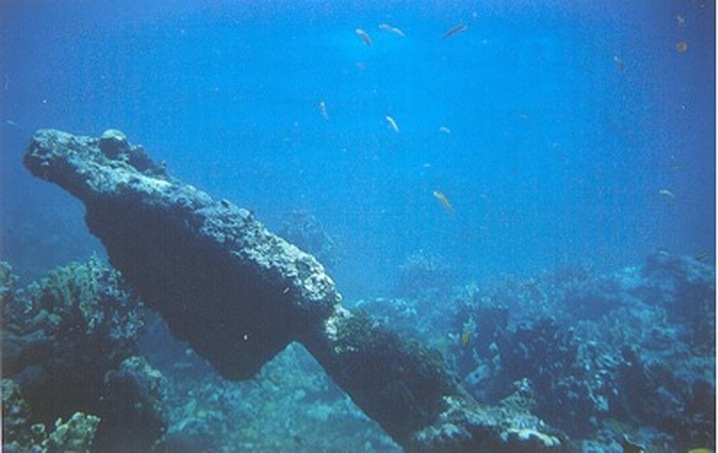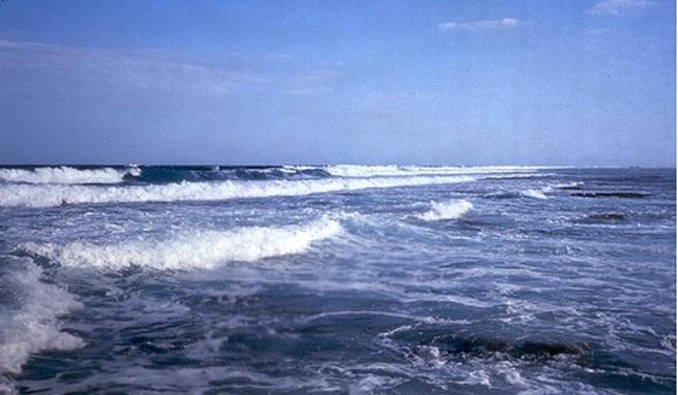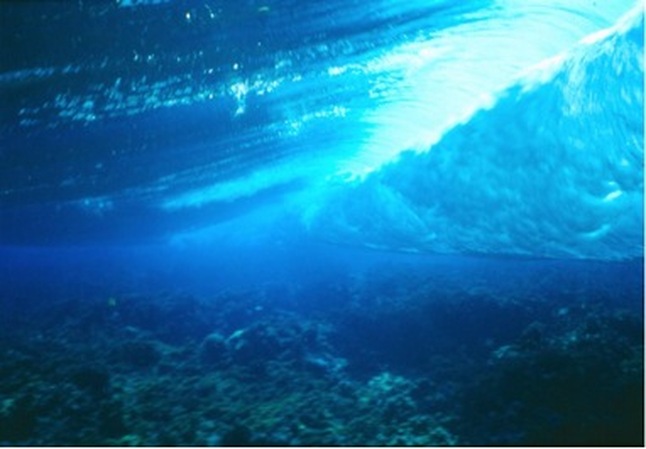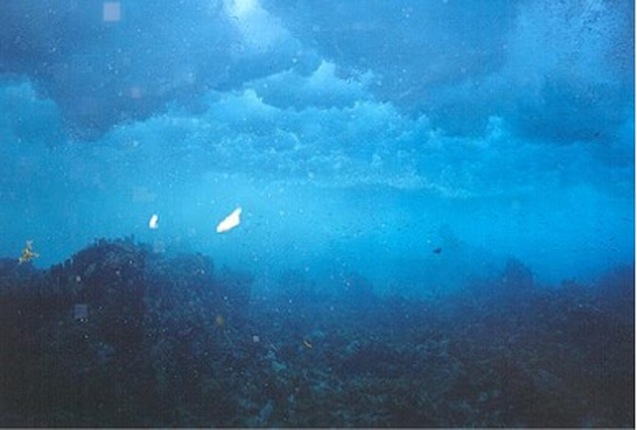“The Curtain” on Recif de la Folle – Haiti
One of the greatest powers of the sea are the immense swells that build up from one side of the world and make their way across the face of the watery planet. To the surface dweller they are known as waves and great enjoyment is seen and felt by the white capped frothing surges to our rocky, sandy seashores. We all see the changes they make to our coasts from eons of time of their relentless work. But doe we really feel the immense power that can pound rock to sand?
One of the greatest powers of the sea are the immense swells that build up from one side of the world and make their way across the face of the watery planet. To the surface dweller they are known as waves and great enjoyment is seen and felt by the white capped frothing surges to our rocky, sandy seashores. We all see the changes they make to our coasts from eons of time of their relentless work. But doe we really feel the immense power that can pound rock to sand?
To someone who works day to day under these natural wave energy sources another side of the story unfolds. A story rich in respect, fear and most of all awe as you give way to their being and always, if you are intelligent, never turning your back on them. For just like some shark species they are never to be trusted, no matter how docile they seem at the moment.
While trying to conduct a historical survey of a reef over 4 miles in length, that is exposed to the open Caribbean, the natural elements of the ocean environment are your work place. An underwater office with calls from another reality. The buck does stop here.
Recif de la Folle has no protection from the effects of wind, current and especially storms that can brew over 1000 miles away. It is right in the middle of what is known as hurricane alley. You have to make careful considerations each day of which direction the wind is blowing. Not just from East, South, and North etc; but also as each degree the compass turns this causes the reef to react in a certain way. Not only is the direction critical but with intensity of strength of the wind in miles per hour this also varies the scene. These changes can happen in minutes, without you even realizing it, while you are busy under the surface world. What might appear to be the same old trade wind direction and strength can actually be quite different when you are in the water, trying to work a certain area.
It actually comes down to the sea itself. It tells you where you are allowed to work that day. It tells you where it is safe or where it is literally deadly. It also tells you many times to stay home for it is in no mood for any visitors as it is just agonizing in energy that can tear metal in half and break wooden beams into splinters. I call this under water limit of viewing for our human species, “The Curtain”.
This curtain is just like a stage production. The sea will allow you to watch with all enjoyment, in relative safety, from the seats in the audience. If you try to go backstage, past the curtain, whether invited or not, you put your day in peril. Everyday the curtain is drawn at a new line on the reef and everyday the curtain changes by the minute. Sometimes it is in 10 feet of water and very seldom is it less than 4 feet. If you happen to follow some twisted channel or trench in the coral and get behind the curtain you can find yourself being smashed, rolled and driven in tons and tons of bubble impregnated foam that you have zero visibility in and about 15 seconds before another one hits. You either get in front of the curtain immediately or you go with the immense push and find yourself driven backwards across razor sharp fanged corals, totally out of breathe and in great anxiety of your safety. I have “enjoyed” the immense adrenaline of both of these situations, therefore I suggest to anyone to learn from my mistakes. Learn about the curtain.
The above photo taken on a better day, was shot with an understanding of how this curtain effect works. From the surface I picked out the edge of an area where 5 to15 foot waves were crashing onto the reef. I then proceeded to this edge of energy, with weights to hold me down if wanted, tight to the bottom but not enough to stop my buoyancy. I then found a coral trench in the reef on the edge of this wave pattern underwater and made my way into the energy zone to where the curtain just began. This path or trench in the coral allowed me to “bottom out” (grab and hold on to the lowest point) when the swell came to avoid being dragged with it. The suction of a wave-passing overhead is ominous if you are not flat hard into the bottom so no water can get under you body to lift it up. After the surge rolled over me I would pop up and try to catch the moment on film. Much like a gopher popping out of a hole, I was able to eventually time it all so I could come up with the above wave, most likely 8 feet high at the leading edge, passing over all the coral. If I had ventured past the leading edge where the curtain started, no matter what hole I was in, the downward crash of the water would swish me around and my life would be in instant jeopardy. Just another foot past this photo the nice looking rolling effect becomes a tormented frothy cauldron as shown below. The power of gravity at work.
Most people picture shipwrecks or what we call “cultural deposits”, as nice neat packages lying on the sea floor ready for a diver to swim thru and enjoy. Unfortunately, over 97% of all shipwrecks prior to 1830 lie in 30 feet of water or less. In short they came to their demise by ramming some sort of land hidden in the waves. After centuries or decades of being immersed in waters full of moving energy these wrecks are scattered like dust in the wind. Ile a Vache Haiti has a maritime history stretching back to the early 1500s with Columbus even passing in 1502. Culture deposits there are extensive and many times stacked up on one another. Being the first diver to ever make a survey of this barrier reef, off the south coast of Haiti, I had the pleasure to unlock some of the mysteries lying there. I also had the pleasure of learning the hard way.
The way Recif de la Folle juts out from land has been a trap for mariners for many reasons. Pilot error is mentioned in 1676 when the JAMAICA MERCHANT, with Sir Henry Morgan on board, came to become part of the reef. The same again is noted in the loss in 1946, of CANADA’S famous schooner the BLUENOSE. With these and dozens of more vessels found there, this coral reef is an underwater museum. Due to the immense energy across this reef most of the wrecks are compacted tight into the reef and are spread all over the reef. It is imperative to be able to get right into the shallowest areas of the reef as I have found wreckage imbedded in the coral wall that has taken hundred of years to grow. In fact one anchor speaks to defy the common rate of known coral growth. You would think from its’ analysis it should be from before the 1500s but we all know this is not possible. European migration and exploration did not happen any earlier than the epoch of Columbus in 1492, unless you want to debate some possible Viking or Roman intrusions much earlier but their anchors where lead and stone.

An anchor fluke 40 inches across and 36 inches long. Most likely from a 50 gun British Ship of the Line lost in 1897. This ship the SALISBURY, named after the ship that found the cure for Scurvy, was the Lt. Governors Ship of Newfoundland, Canada - before this province was even in the Canadian Confederation.
As you gauge the degree of the curtain everyday, new scenes unfold as the curtain gets smaller and allows you to go in shallower. I have been on the reef site hundreds of hours and many weeks and can only recall a few hours here and there where you could get in tight to the coral wall. This is the wall where the ancient coral reef has grown out to over the last 20,000 years. It is where the last few feet go straight up onto the coral reef shelf itself. Embedded in this wall are the dreams and aspirations of many sailors. Embedded in this wall are the remains of hundreds who drowned or where ripped apart in a vicious storm that claimed their vessel. British, French, Spanish and even the Arwak Indians of the Caribbean all have lost souls to the powerful energy this reef omits. Even today boats are floundering on it and lives are being lost. Just last year a poor Haitian vessel began sinking here and many locals lost their lives. It is a place a curtain raising, due to calm weather, can tell so many plays but it is a place you must wait your turn for the next act. If you rush to see the whole play at once, you are rushing to certain doom. Like all great plays you must wait for the final scene and let the curtain fall where it may. Just be sure your are in the audience when it does fall or you too will become part of the act.
written by Bruce Leeming
written by Bruce Leeming



